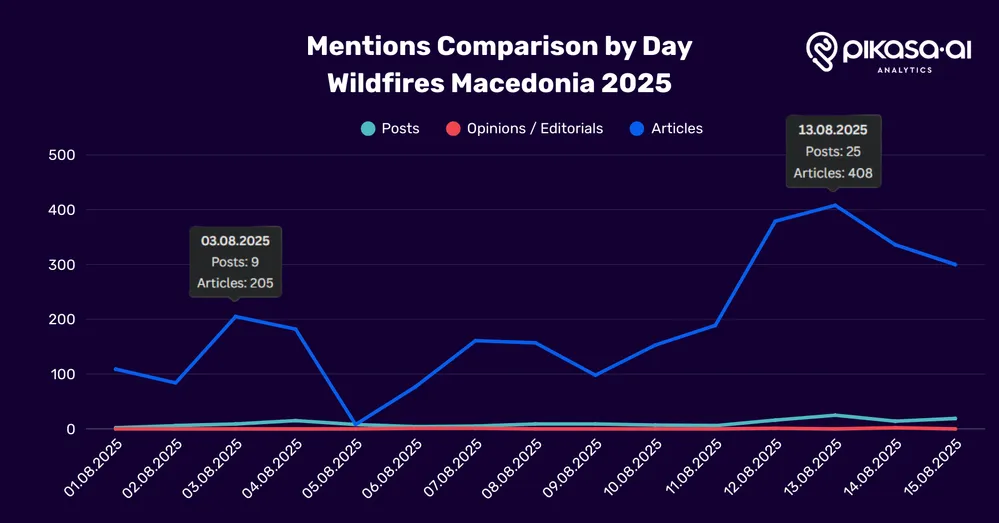When Flames Spread, So Do Stories - Wildfires in North Macedonia in Media and Social Media
Wildfires Burned the Land and Lit Up the Media
In August 2025, North Macedonia was gripped by wildfires that raged across hillsides and threatened villages. But the flames did not only consume land, they also ignited a parallel firestorm of information. The wildfire crisis in North Macedonia was not only about burning forests but also about institutions (Government, Ministry of Interior, Army Protection and Rescue Directorate) and leaders being placed under the spotlight. Media outlets, and social platforms became the arenas where wildfire was explained, politicized, and emotionally processed.
Between 1 and 15 August 2025, Pikasa.ai through its real-time media monitoring platform Analytics.Live monitored more than 300 digital media outlets and thousands of social media channels. In just two weeks, we identified almost 2,000 online articles published by media outlets, alongside dozens of Facebook, Instagram, TikTok, and YouTube posts. Together, the wildfire narrative became a stage where operational responsibility collided with political rivalry, a pattern Pikasa Analytics observes regularly in crisis reporting.
Media vs. Social Media: Parallel Fires
- Media coverage peaked on 13 August, with 408 articles in a single day. Outlets such as Telma, Sloboden Pechat, Alsat-M, Kanal 5, and 24 Vesti focused on firefighting capacity, official press briefings, and political responsibility. Wildfires became a stage for debates on government preparedness.
- Social media told the story through the eyes of citizens. Activity was steady across the first two weeks of August, with daily posts on Facebook, Instagram, TikTok, and YouTube. The strongest surge came on 13 August, when citizens uploaded 12 Facebook posts, 7 Instagram posts, 2 TikTok clips, and 6 YouTube videos in one day, extending the story with raw visuals, donation appeals, and solidarity campaigns.
This contrast shows that media set the initial agenda, while social platforms extended the story’s life through personal voices and grassroots mobilization.
Engagement on Fire: What People Clicked, Shared, and Reacted To
- Articles dominated by volume, with nearly 2,000 wildfire-related pieces published between 1-15 August. But their engagement was spread thin across that massive output.
- Social media content, though smaller in number, consistently sparked higher interactions per post. The most viral content came from Facebook and TikTok videos showing flames approaching homes and exhausted firefighters, drawing thousands of reactions, comments, and shares.
The lesson is clear: authenticity wins. Citizens trust shaky videos and firsthand accounts more than polished press releases.

From Shock to Solidarity: How Narratives Shifted
Across the two weeks of monitoring, Pikasa Analytics identified three evolving clusters of wildfire narratives in North Macedonia:
- Shock (1 - 5 August): reporting grew rapidly, jumping from 109 articles on 1 August to 182 by 4 August, as coverage focused on the spread of flames and immediate danger.
- Blame (6 - 13 August): the story turned political, with articles and talk shows debating government preparedness, firefighting capacity, and resource shortages. By 13 August, coverage reached 408 articles in one day.
- Solidarity (14 - 15 August): as the flames subsided, the digital space shifted toward community resilience. On 15 August alone, dozens of Facebook, Instagram, TikTok, and YouTube posts highlighted volunteers, donation drives, and collective efforts to protect homes and rebuild.
This rhythm: shock → blame → solidarity - mirrors how societies process crises. Understanding it helps explain when emotions run highest and when opportunities for constructive storytelling appear.
Who Drove the Story? Media Outlets vs. Citizen Voices
- Top outlets such as Telma, Sloboden Pechat, Alsat-M, Kanal 5, and 24 Vesti framed the fires as both a natural disaster and a test of government credibility.
- Citizen-led social media pages and community groups provided raw authenticity. Volunteer firefighters’ clips, shaky phone footage, and neighbor-to-neighbor warnings reached audiences far beyond traditional headlines.
In crises, hierarchies collapse - citizens become the most trusted narrators.
Key Insights from Pikasa Analytics
- Timing Matters in Crisis Communication - Both media and social media peaked at the height of danger. Institutions must react immediately and transparently.
- Diverging Narratives: Accountability vs. Solidarity - Media sought accountability. Citizens emphasized solidarity. Both are necessary.
- Engagement as a Measure of Trust - The most shared content was grassroots-driven. Institutions must amplify these voices rather than overshadow them.
- Communication Preparedness in Future Disasters - Preparedness isn’t only about equipment. It’s also about having maps, hotline numbers, and visuals ready to combat misinformation.
Why This Matters
The 2025 wildfires in North Macedonia prove that disasters unfold not only in forests and towns but also in the information ecosystem. Monitoring this ecosystem is vital for understanding how narratives spread, which voices dominate, and how communities respond.
At Pikasa Analytics, we use media monitoring, social media analytics, and narrative clustering to turn crises into data-driven lessons. By mapping both articles and posts, we show how digital engagement reflects public fear, anger, and solidarity, and why those emotions matter for future preparedness.
By understanding how media and social media narratives evolve, institutions and citizens alike can better prepare for future crises. These findings remind us: every crisis is also a story, and every story shapes recovery.
Written by
Natasha Dimova
August 21, 2025